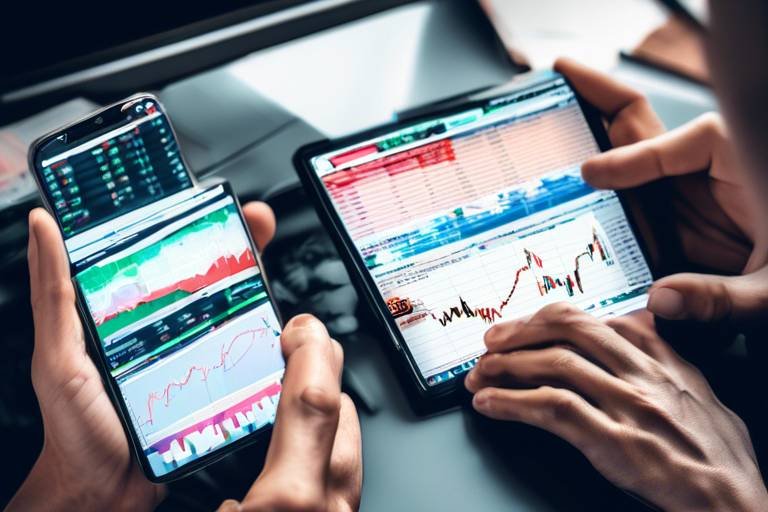How to Utilize Economic Indicators in Crypto Trading
In the fast-paced world of cryptocurrency trading, understanding the intricacies of economic indicators can be a game changer. Economic indicators are like the compass that guides traders through the tumultuous waters of the crypto market. They provide critical insights into the broader economic landscape, helping traders make informed decisions. But how exactly can you leverage these indicators to enhance your trading strategies? Let's dive into the essential role these metrics play and how you can use them to your advantage.
Imagine you're navigating a ship through a stormy sea. Without a reliable compass, you could easily lose your way. Similarly, economic indicators serve as your navigational tools in the vast ocean of cryptocurrency. They help you gauge market conditions and anticipate potential price movements. By understanding how these indicators work, you can position yourself to capitalize on market trends, making your trading experience not only more profitable but also less stressful.
As we explore this topic, we'll break down the various types of economic indicators, including their relevance to the cryptocurrency market. From Gross Domestic Product (GDP) to inflation rates and interest rates, each metric provides unique insights that can influence your trading decisions. So, buckle up and get ready to enhance your trading toolkit with the power of economic indicators!
Economic indicators are vital statistics that reflect the health of an economy. They can be broadly categorized into three types: leading, lagging, and coincident indicators. Leading indicators, such as stock market performance and consumer sentiment, provide foresight into future economic activity. Lagging indicators, like unemployment rates and corporate profits, confirm trends after they have occurred. Coincident indicators, such as GDP and retail sales, move in tandem with the economy and provide real-time data.
For cryptocurrency traders, understanding these indicators is crucial because they can signal shifts in market sentiment and investor behavior. For instance, if consumer confidence is high, it could lead to increased investment in cryptocurrencies. Conversely, if unemployment rises, it might trigger a sell-off as investors pull back on riskier assets. By keeping an eye on these indicators, traders can better anticipate market movements and adjust their strategies accordingly.
Identifying which economic indicators matter most for crypto trading can significantly enhance your strategies. Here are some primary indicators that traders should monitor regularly:
- Gross Domestic Product (GDP): Measures economic activity and growth.
- Inflation Rates: Affects purchasing power and investment strategies.
- Interest Rates: Set by central banks, impacting capital flow into cryptocurrencies.
GDP is a critical measure of economic activity and growth. It reflects the total value of all goods and services produced over a specific time period. When GDP is on the rise, it often correlates with increased investment in cryptocurrencies, as a healthy economy encourages risk-taking. Traders need to pay attention to GDP growth trends, as they can provide valuable insights into future market movements.
A growing GDP typically signifies a robust economy, which can lead to increased investment in cryptocurrencies. Traders can interpret GDP growth trends by analyzing historical data and current economic conditions. For example, if GDP growth is accelerating, it may indicate a favorable environment for crypto investments, prompting traders to increase their positions.
On the flip side, recessions can lead to heightened market volatility. Recognizing recession indicators, such as declining GDP or increasing unemployment rates, is essential for traders. These signals can prompt traders to adopt more cautious strategies, such as reducing exposure to high-risk assets like cryptocurrencies.
Inflation rates play a pivotal role in shaping purchasing power and investment strategies. When inflation rises, the value of money decreases, prompting investors to seek alternative assets like cryptocurrencies to preserve their wealth. Conversely, falling inflation may lead to a more stable economic environment, affecting crypto trading behavior.
Interest rates set by central banks can significantly impact the flow of capital into cryptocurrencies. When central banks raise interest rates, borrowing becomes more expensive, potentially leading to reduced investments in riskier assets, including cryptocurrencies. Conversely, lower interest rates can encourage borrowing and investment, creating a favorable environment for crypto traders.
Central banks' monetary policies directly influence interest rates. Traders should closely monitor central bank announcements and policy changes, as these can provide hints about future market movements. For instance, if a central bank signals a shift towards lower interest rates, it could lead to a surge in crypto investments.
Market sentiment often shifts in response to economic data releases. Traders can gauge sentiment through economic indicators, adjusting their strategies accordingly. For example, if positive employment data is released, it may boost investor confidence and lead to increased buying in the crypto market. Understanding these dynamics can help traders stay ahead of the curve and make more informed decisions.
Q: How can economic indicators help me in crypto trading?
A: Economic indicators provide insights into the overall health of the economy, helping you gauge market sentiment and make informed trading decisions.
Q: Which economic indicators should I focus on?
A: Key indicators include GDP, inflation rates, and interest rates. Monitoring these can enhance your trading strategies.
Q: How do central bank policies affect cryptocurrency trading?
A: Central bank policies influence interest rates, which can impact capital flow into cryptocurrencies. Keeping an eye on these policies can help you anticipate market movements.

Understanding Economic Indicators
Economic indicators are like the pulse of the economy, providing vital statistics that reflect its overall health. Just as a doctor checks vital signs to assess a patient's condition, traders use these indicators to gauge market dynamics and make informed decisions. In the realm of cryptocurrency trading, understanding these indicators is crucial. They can help you predict market movements and identify potential investment opportunities. But what exactly are these indicators, and how do they relate to the ever-changing world of cryptocurrencies?
At their core, economic indicators can be categorized into three main types: leading, lagging, and coincident indicators. Leading indicators, such as stock market performance or consumer confidence, often predict future economic activity. Lagging indicators, like unemployment rates or GDP, reflect past performance, while coincident indicators, such as retail sales, occur simultaneously with economic events. For crypto traders, keeping an eye on these indicators can provide a comprehensive view of market trends and investor sentiment.
For instance, when consumer confidence is high, people are more likely to invest in riskier assets like cryptocurrencies. Conversely, if unemployment rates rise, it could signal a bearish trend, leading traders to exercise caution. Understanding these nuances can empower you to make better trading decisions and anticipate market shifts before they happen.
Moreover, the relevance of economic indicators extends beyond traditional finance. The cryptocurrency market is influenced by a myriad of factors, including macroeconomic trends, regulatory developments, and technological advancements. As a trader, you must not only analyze economic data but also consider how these factors interplay with the crypto landscape. By doing so, you can develop a more robust trading strategy that accounts for both economic conditions and market sentiment.
In conclusion, grasping the significance of economic indicators is essential for anyone looking to navigate the complexities of crypto trading. By staying informed and understanding how these indicators impact the market, you can enhance your trading strategies and make more informed decisions. So, the next time you check the market, remember to consider the economic indicators that might be influencing price movements. They could very well be the key to unlocking your trading potential!
- What are economic indicators? Economic indicators are statistics that provide insights into the health of an economy, helping traders make informed decisions.
- Why are economic indicators important for crypto trading? They help traders predict market movements and understand investor sentiment, which is crucial for making strategic trading decisions.
- What types of economic indicators should I monitor? Key indicators include GDP, inflation rates, and interest rates, among others.

Key Economic Indicators for Crypto Traders
When diving into the world of crypto trading, understanding the landscape of economic indicators is not just beneficial—it's essential. These indicators act as the compass guiding traders through the often turbulent waters of the cryptocurrency market. By keeping an eye on specific economic metrics, traders can make informed decisions that enhance their strategies and potentially lead to profitable outcomes. But what exactly are these indicators, and why do they matter? Let’s break it down.
First and foremost, it's important to recognize that not all economic indicators are created equal. While some may offer insights into general market trends, others can directly impact the price movements of cryptocurrencies. Here are a few key indicators that every crypto trader should monitor:
- Gross Domestic Product (GDP): A measure of economic activity and growth.
- Inflation Rates: These rates can affect purchasing power and investment strategies.
- Interest Rates: Set by central banks, these can influence the flow of capital into cryptocurrencies.
- Employment Rates: High employment often correlates with increased consumer spending and investment confidence.
Monitoring these indicators can provide traders with a clearer picture of market conditions. For instance, when GDP is on the rise, it often signals a healthy economy, which can lead to increased investment in cryptocurrencies. Conversely, a declining GDP may induce fear and uncertainty, prompting traders to reevaluate their positions.
Another crucial indicator is the inflation rate. High inflation typically erodes purchasing power, leading investors to seek alternative assets like cryptocurrencies as a hedge against inflation. On the flip side, low inflation can signal a stable economy, but it may also indicate lower returns on investments, prompting traders to rethink their strategies.
Interest rates, too, play a pivotal role in shaping the crypto landscape. When central banks raise interest rates, borrowing costs increase, potentially leading to reduced investment in riskier assets like cryptocurrencies. Conversely, lower interest rates can stimulate investment, as cheap capital encourages traders to explore higher-yielding opportunities in the crypto market.
Understanding these indicators is not just about recognizing numbers; it’s about interpreting them within the context of the market. For example, if the employment rate is rising while inflation remains stable, this could indicate a robust economy. Traders may see this as a signal to invest in cryptocurrencies, anticipating that increased consumer confidence will drive demand.
In conclusion, keeping a close eye on these economic indicators can provide traders with a significant edge in the crypto market. By understanding how these metrics influence market dynamics, traders can better position themselves to capitalize on opportunities and mitigate risks. As the crypto landscape continues to evolve, those who stay informed will undoubtedly be better equipped to navigate the challenges ahead.

Gross Domestic Product (GDP)
Gross Domestic Product, commonly referred to as GDP, is a fundamental economic indicator that measures the total value of all goods and services produced over a specific time period within a country. It's like the scoreboard of a nation's economic performance, providing insights into how well the economy is doing. In the context of cryptocurrency trading, understanding GDP is crucial because it directly influences investor sentiment and market dynamics. When GDP figures are released, they can cause ripples across various asset classes, including cryptocurrencies.
For instance, if a country's GDP is growing, it often signifies a robust economy, leading to increased investor confidence. In such scenarios, traders might observe a surge in cryptocurrency investments as people look to capitalize on the positive economic outlook. Conversely, a declining GDP can trigger fear and uncertainty, pushing investors to withdraw from riskier assets like cryptocurrencies. This relationship between GDP and crypto prices is vital for traders aiming to make informed decisions.
Let's break down how fluctuations in GDP can impact cryptocurrency markets:
- Positive GDP Growth: When GDP growth is reported, it can lead to increased liquidity in the market. Investors may feel more secure putting their money into cryptocurrencies, anticipating that a strong economy will support higher asset prices.
- Negative GDP Growth: A contraction in GDP often signals economic trouble. During these times, traders may become risk-averse, leading to a sell-off in cryptocurrencies as investors seek safer assets.
Moreover, the impact of GDP on cryptocurrency trading isn't just about the numbers; it's also about the psychological effects on traders. Market sentiment can shift dramatically based on GDP reports, creating opportunities for savvy traders who can read the signs. For example, if a country announces a surprising increase in GDP that beats expectations, it might lead to a sudden influx of capital into the crypto space as traders react to the positive news.
In conclusion, GDP serves as a critical barometer for traders in the cryptocurrency market. By keeping an eye on GDP trends and understanding their implications, traders can better navigate the often volatile waters of crypto trading. Whether it's a booming economy or a looming recession, GDP insights can provide the necessary context for making strategic trading decisions.

Impact of GDP Growth
The relationship between Gross Domestic Product (GDP) growth and the cryptocurrency market is a fascinating one. When GDP is on the rise, it often signals a robust economy, which can lead to increased investor confidence. This confidence can translate into higher investments in various assets, including cryptocurrencies. Think of GDP growth as a rising tide that lifts all boats; when the economy flourishes, many investors feel more secure in their financial decisions and are more likely to explore emerging markets like crypto.
One of the key ways GDP growth impacts cryptocurrency trading is through the influx of institutional investors. As economic conditions improve, institutions tend to allocate more funds towards alternative investments, including digital currencies. This can lead to a surge in demand, driving up prices. For instance, during periods of strong GDP growth, we often witness a spike in Bitcoin and Ethereum valuations, as these currencies become more attractive to both retail and institutional investors alike.
Moreover, GDP growth can also influence the overall market sentiment. A thriving economy can create a positive feedback loop; as people feel more financially secure, they are more likely to invest in riskier assets, such as cryptocurrencies. On the flip side, if GDP growth is stagnant or declining, the opposite effect can take place, leading to a more cautious investment approach. In such scenarios, traders might pull back from crypto investments, fearing that economic instability could lead to significant losses.
To illustrate this relationship, consider the following table that outlines the correlation between GDP growth rates and cryptocurrency market performance over the past few years:
| Year | GDP Growth Rate (%) | Bitcoin Price Change (%) |
|---|---|---|
| 2020 | -3.4 | -40 |
| 2021 | 5.7 | 300 |
| 2022 | 4.0 | 50 |
| 2023 | 3.5 | 80 |
This table clearly shows that as GDP growth rates increase, the price changes in Bitcoin have often followed suit. While correlation does not imply causation, the trends suggest that traders should keep a close eye on GDP reports. By understanding the broader economic landscape, they can make more informed decisions about when to enter or exit the cryptocurrency market.
In conclusion, the impact of GDP growth on cryptocurrency trading cannot be overstated. Traders who monitor GDP trends and understand their implications will be better positioned to navigate the volatile crypto landscape. Whether it's recognizing the potential for increased investment during periods of growth or anticipating market pullbacks during economic slowdowns, the insights gained from GDP data can be invaluable in crafting effective trading strategies.

GDP Recession Indicators
Recognizing is crucial for crypto traders who want to navigate the often turbulent waters of the cryptocurrency market. A recession, typically defined as two consecutive quarters of negative GDP growth, can send shockwaves through financial markets, including digital currencies. When the economy contracts, consumer spending usually declines, leading to reduced investment in riskier assets like cryptocurrencies. This creates a ripple effect that can cause significant price volatility.
Traders should pay attention to several key indicators that may signal an impending recession:
- Declining GDP Growth Rates: A slowdown in GDP growth can be an early warning sign. If you notice a consistent decline in quarterly growth rates, it might be time to reassess your crypto investments.
- High Unemployment Rates: Increased unemployment often correlates with decreased consumer spending, which can negatively impact the demand for cryptocurrencies.
- Decreased Consumer Confidence: When consumers feel less confident about the economy, they tend to hold back on spending, leading to a decrease in investment in cryptocurrencies.
- Falling Industrial Production: A decline in industrial output can indicate a slowing economy, which may lead to reduced interest in speculative assets like cryptocurrencies.
Understanding these indicators can help traders make informed decisions. For instance, if GDP growth is slowing down and unemployment is rising, it might be wise to consider hedging your crypto investments or even liquidating some positions. Conversely, if you see signs of recovery, such as an uptick in GDP growth or improvements in consumer sentiment, it might signal a good time to invest.
Moreover, it's essential to stay updated on economic reports and forecasts. Many financial news outlets provide regular updates on GDP statistics, and keeping an eye on these can provide valuable insights. By integrating economic indicators into your trading strategy, you can better anticipate market movements and adjust your approach accordingly. Remember, in the world of crypto trading, knowledge is power, and understanding the broader economic landscape can give you a significant edge.

Inflation Rates
Inflation rates are like the heartbeat of an economy, indicating how quickly prices are rising and, consequently, how much purchasing power is being eroded. For crypto traders, understanding inflation is crucial because it can significantly influence investment strategies and market behavior. When inflation rises, the value of traditional currencies tends to decline, pushing investors to seek alternative assets like cryptocurrencies. But how does this all play out in the real world?
Imagine you’re at a grocery store, and you notice that the price of your favorite snack has jumped from $2 to $3 in just a few months. This increase doesn’t just affect your snack budget; it reflects a broader economic trend that can drive investors towards cryptocurrencies as a hedge against inflation. When inflation rates are high, the appeal of cryptocurrencies can surge as they are often viewed as a store of value, similar to gold. This perception can lead to increased demand, driving prices up.
Conversely, when inflation is low or stable, traditional investments like stocks and bonds may seem more attractive. Investors might feel secure in holding onto their fiat currencies, leading to a decrease in demand for cryptocurrencies. Thus, traders need to keep a close eye on inflation data releases and understand how these figures can affect market sentiment.
To better grasp the impact of inflation on crypto trading, let’s look at some key factors:
- Consumer Price Index (CPI): This is one of the most widely used indicators of inflation. A rising CPI indicates increasing prices, which can lead to a shift in investment strategies.
- Central Bank Responses: High inflation often prompts central banks to raise interest rates. This can lead to decreased liquidity in the markets, affecting crypto investments.
- Investor Behavior: During periods of high inflation, investors may flock to cryptocurrencies as a hedge, leading to increased volatility and potential price surges.
In summary, inflation rates play a pivotal role in shaping the landscape of crypto trading. By understanding how inflation affects purchasing power and market dynamics, traders can make more informed decisions. Keeping an eye on inflation trends can provide insights into potential market movements, allowing traders to adjust their strategies effectively. So, the next time you hear about rising inflation, remember that it could be a signal for potential opportunities in the crypto market!
Q: How do inflation rates impact cryptocurrency prices?
A: Inflation rates can lead to increased demand for cryptocurrencies as investors seek to protect their purchasing power. When inflation is high, traditional currencies lose value, making cryptocurrencies more appealing.
Q: What indicators should I watch for inflation trends?
A: Key indicators include the Consumer Price Index (CPI), Producer Price Index (PPI), and central bank announcements regarding monetary policy.
Q: How often are inflation rates reported?
A: Inflation rates are typically reported monthly, but central banks may release additional information based on economic conditions.
Q: Can cryptocurrencies be considered a hedge against inflation?
A: Many investors view cryptocurrencies as a hedge against inflation due to their limited supply and decentralized nature, which can protect against currency devaluation.

Interest Rates and Crypto Markets
Interest rates, set by central banks, play a pivotal role in shaping the economic landscape and can significantly influence the cryptocurrency markets. When central banks adjust interest rates, they are essentially altering the cost of borrowing money, which can lead to shifts in investment behavior. For instance, when interest rates are low, borrowing becomes cheaper, encouraging both consumers and businesses to spend and invest more. This increased liquidity can flow into various asset classes, including cryptocurrencies. Conversely, high interest rates can lead to tighter financial conditions, often causing investors to pull back on riskier investments like cryptocurrencies.
Understanding the relationship between interest rates and crypto markets is crucial for traders looking to maximize their profits. When interest rates rise, traditional investments such as bonds and savings accounts become more attractive due to higher returns. This can lead to a decrease in capital flowing into cryptocurrencies, as investors may prefer the safety of traditional assets. On the other hand, when interest rates fall, the opportunity cost of holding non-yielding assets like Bitcoin decreases, potentially driving more investors towards the crypto market. It’s a delicate dance, and savvy traders need to stay informed about central bank policies and interest rate trends to navigate this complex environment effectively.
Central banks, like the Federal Reserve in the United States, have a tremendous influence on interest rates through their monetary policies. When they announce changes to interest rates, it can send shockwaves through the financial markets, including cryptocurrencies. For example, a recent decision to lower interest rates can lead to a surge in crypto prices as investors seek higher returns in a low-yield environment. Traders should pay close attention to these announcements and consider how they might affect market sentiment and liquidity.
Moreover, the anticipation surrounding central bank meetings and the subsequent interest rate decisions can create volatility in the crypto markets. Traders often speculate on the outcomes of these meetings, leading to price fluctuations even before any official announcement is made. Therefore, keeping an eye on economic calendars and understanding the implications of monetary policy shifts is essential for anyone serious about crypto trading.
The sentiment in the crypto market can be highly reactive to economic data releases, particularly those related to interest rates. When economic indicators suggest that the economy is strengthening, leading to potential interest rate hikes, traders might become bearish on cryptocurrencies, fearing that higher rates could reduce demand. Conversely, if economic data indicates weakness, traders may anticipate that central banks will lower rates, which could boost interest in cryptocurrencies as an alternative investment.
To gauge market sentiment effectively, traders can utilize various tools and resources, including:
- Social media sentiment analysis tools
- Crypto market analytics platforms
- Economic news aggregators
By keeping a pulse on how both economic indicators and market sentiment interact, traders can adjust their strategies to better align with potential market movements. This proactive approach can lead to improved decision-making and ultimately, more successful trading outcomes.

Central Bank Policies
The role of central banks in the economy is akin to the conductor of an orchestra, guiding the flow of capital and influencing the overall harmony of financial markets. When central banks announce changes in their monetary policies, it can send ripples through the crypto markets, affecting everything from investor sentiment to the price of Bitcoin. So, how exactly do these policies impact crypto trading? Let’s delve deeper.
Central banks, such as the Federal Reserve in the United States or the European Central Bank in the Eurozone, set interest rates that determine the cost of borrowing money. When interest rates are low, borrowing becomes cheaper, encouraging both consumers and businesses to spend and invest. This influx of capital often leads to increased investment in riskier assets, including cryptocurrencies. Conversely, when interest rates rise, it can lead to a tightening of liquidity in the market, causing investors to pull back from speculative investments like crypto.
For traders, understanding the nuances of central bank policies is crucial. Here are a few key points to consider:
- Interest Rate Decisions: Traders should closely monitor announcements regarding interest rate changes. A rate hike might signal a bearish trend in the crypto market, while a rate cut could indicate a bullish outlook.
- Quantitative Easing: When central banks engage in quantitative easing, they inject money into the economy by purchasing government securities. This can lead to increased liquidity, often resulting in a surge in crypto investments.
- Forward Guidance: Central banks often provide forward guidance about their future policy intentions. This can help traders anticipate market movements and adjust their strategies accordingly.
To illustrate the impact of central bank policies on the crypto market, let’s take a look at a hypothetical scenario:
| Central Bank Action | Market Reaction | Potential Impact on Crypto |
|---|---|---|
| Interest Rate Decrease | Increased borrowing and spending | Higher investment in cryptocurrencies |
| Interest Rate Increase | Decreased borrowing and spending | Lower demand for cryptocurrencies |
| Quantitative Easing Announced | Increased liquidity in markets | Surge in crypto prices |
In summary, central bank policies play a pivotal role in shaping the landscape of the crypto market. Traders who stay informed about these policies can better navigate the complexities of the market, making more informed decisions that align with economic trends. By understanding the relationship between interest rates and cryptocurrency investments, traders can position themselves to capitalize on market movements, whether they are bullish or bearish.
Q: How do central bank policies affect cryptocurrency prices?
A: Central bank policies influence interest rates and liquidity in the market, which can lead to increased or decreased investment in cryptocurrencies depending on the economic climate.
Q: What is quantitative easing, and how does it relate to crypto?
A: Quantitative easing is a monetary policy where central banks purchase securities to increase money supply. This can lead to more capital flowing into cryptocurrencies as investors seek higher returns.
Q: Should I follow central bank announcements as a crypto trader?
A: Yes, staying updated on central bank announcements can provide valuable insights into market trends and help you make informed trading decisions.

Market Sentiment and Economic Data
When it comes to trading in the volatile world of cryptocurrencies, understanding market sentiment is like having a compass in a stormy sea. Market sentiment refers to the overall attitude of investors toward a particular security or financial market. It can be influenced by various factors, including economic data releases, news events, and social media trends. Traders who can accurately gauge market sentiment can position themselves more effectively to capitalize on potential price movements.
Economic data plays a critical role in shaping market sentiment. For instance, when key economic indicators such as unemployment rates, inflation figures, or GDP growth are released, they can create ripples in the market. Positive data often leads to a bullish sentiment, where traders feel optimistic and are more likely to buy cryptocurrencies. Conversely, negative data can trigger a bearish sentiment, prompting traders to sell off their assets in anticipation of declining prices.
One of the most effective ways to track market sentiment is through the use of sentiment analysis tools. These tools analyze social media posts, news articles, and other online content to determine whether the overall sentiment is positive, negative, or neutral. By using these tools, traders can gain insights into how the broader market is feeling about specific cryptocurrencies or the market as a whole. This analysis can help traders make informed decisions about when to enter or exit a position.
Moreover, keeping an eye on the fear and greed index can also provide valuable insights into market sentiment. This index measures the emotions and sentiments of investors and can be a useful tool for traders looking to gauge the market's mood. When the index indicates extreme fear, it might be a signal to buy, while extreme greed could suggest it’s time to sell. Understanding these emotional cues can be the difference between a successful trade and a missed opportunity.
In summary, market sentiment is a powerful force in the crypto trading landscape. By paying close attention to economic data and utilizing sentiment analysis tools, traders can navigate the complexities of the market with greater confidence. As the saying goes, "the market is always right," and understanding the collective mindset of investors can lead to more strategic trading decisions.
- What is market sentiment? Market sentiment refers to the overall attitude of investors toward a particular security or market, influenced by various factors including economic data.
- How can economic data affect market sentiment? Economic data releases can create positive or negative sentiments, influencing traders' decisions to buy or sell cryptocurrencies.
- What tools can I use to gauge market sentiment? Sentiment analysis tools and the fear and greed index are popular methods for assessing market sentiment.
- Why is understanding market sentiment important for crypto trading? Understanding market sentiment helps traders make informed decisions, allowing them to capitalize on potential price movements.
Frequently Asked Questions
- What are economic indicators?
Economic indicators are statistical data that provide insights into the overall health and direction of an economy. They can include metrics such as GDP, inflation rates, and employment figures, which are crucial for traders to understand market trends and make informed decisions.
- How do GDP fluctuations affect cryptocurrency prices?
Fluctuations in Gross Domestic Product (GDP) can significantly influence investor sentiment and market dynamics. A growing GDP often leads to increased investment in cryptocurrencies, while a declining GDP may create uncertainty, impacting prices negatively.
- What role do inflation rates play in crypto trading?
Inflation rates directly affect the purchasing power of money, which in turn influences investment strategies. Rising inflation can lead traders to seek alternative assets like cryptocurrencies, while falling inflation may stabilize traditional investments.
- How do interest rates impact the crypto market?
Interest rates set by central banks can affect the flow of capital into cryptocurrencies. Lower interest rates may encourage investment in riskier assets like crypto, while higher rates could drive investors back to safer, traditional investments.
- What is the significance of central bank policies for crypto traders?
Central bank policies are crucial as they determine interest rates and influence market liquidity. Traders often analyze central bank announcements to anticipate market movements and adjust their trading strategies accordingly.
- How can traders gauge market sentiment using economic data?
Traders can assess market sentiment by monitoring economic data releases and their effects on price movements. Positive economic indicators can boost sentiment, while negative data can lead to market downturns, allowing traders to make timely decisions.



















